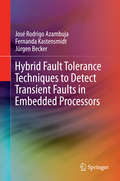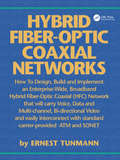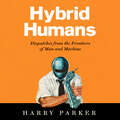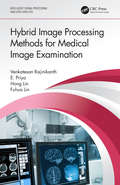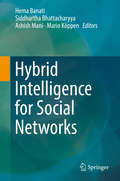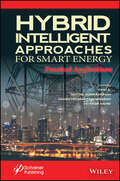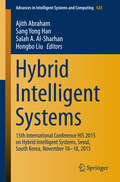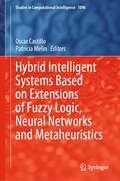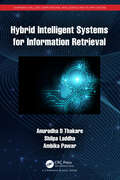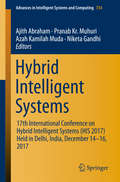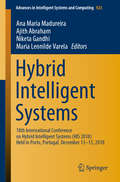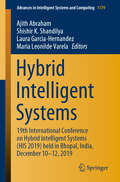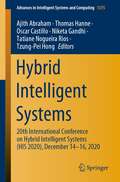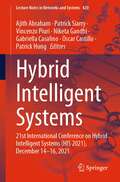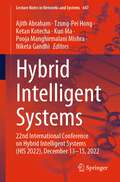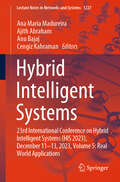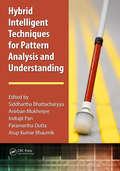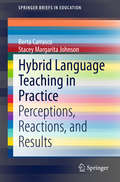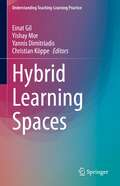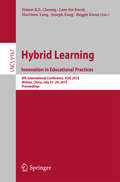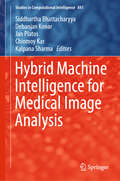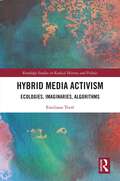- Table View
- List View
Hybrid Fault Tolerance Techniques to Detect Transient Faults in Embedded Processors
by Jürgen Becker José Rodrigo Azambuja Fernanda KastensmidtThis book describes fault tolerance techniques based on software and hardware to create hybrid techniques. They are able to reduce overall performance degradation and increase error detection when associated with applications implemented in embedded processors. Coverage begins with an extensive discussion of the current state-of-the-art in fault tolerance techniques The authors then discuss the best trade-off between software-based and hardware-based techniques and introduce novel hybrid techniques. Proposed techniques increase existing fault detection rates up to 100%, while maintaining low performance overheads in area and application execution time.
Hybrid Fiber-Optic Coaxial Networks: How to Design, Build, and Implement an Enterprise-Wide Broadband HFC Network
by Ernest TunmannThis book covers the planning, design and implementation of hybrid fiber-optic coaxial (HFC) broadband networks in schools, universities, hospitals, factories and offices, whether they are in a single building or multiple campuses. Within the next few yea
Hybrid Genetic Optimization for IC Chips Thermal Control: With MATLAB® Applications (Advances in Metaheuristics)
by Mathew V. K. Tapano Kumar HottaThe continuous miniaturization of integrated circuit (IC) chips and the increase in the sleekness of the design of electronic components have led to the monumental rise of volumetric heat generation in electronic components. Hybrid Genetic Optimization for IC Chips Thermal Control: With MATLAB® Applications focuses on the detailed optimization strategy carried out to enhance the performance (temperature control) of the IC chips oriented at different positions on a switch-mode power supply (SMPS) board and cooled using air under various heat transfer modes. Seven asymmetric protruding IC chips mounted at different positions on an SMPS board are considered in the present study that is supplied with non-uniform heat fluxes. Key Features: Provides guidance on performance enhancement and reliability of IC chips Provides a detailed hybrid optimization strategy for the optimal arrangement of IC chips on a board The MATLAB program for the hybrid optimization strategy along with its stability analysis is carried out in a detailed manner Enables thermal design engineers to identify the positioning of IC chips on the board to increase their reliability and working cycle
Hybrid Humans: Dispatches from the Frontiers of Man and Machine
by Harry Parker"I loved Hybrid Humans. It is modest, wise ... and a way of looking at the future without nostalgia for the past" Jeanette Winterson"Harry Parker has explored the cutting edge of interaction between humanity, computing and AI ... a captivating and cautionary travel guide to a new world" Gavin Francis, author of Adventures in Human BeingIs your mobile phone thinking for you? Do your rely more on Google than your own memory?Harry Parker's life changed overnight, when he lost his legs to an IED in Afghanistan. That took him into an often surprising landscape of a very human kind of hacking, and he wondered, are all humans hybrids?Whether it's putting on contact lenses every day or DIY biohackers tinkering in garages, Parker introduces us to the exhilarating breadth of human invention - and intervention. Grappling with his own new identity and disability, he discovers the latest robotics, tech and implants that might lead us to powerful, liberating possibilities for what a body can be.
Hybrid Image Processing Methods for Medical Image Examination (Intelligent Signal Processing and Data Analysis)
by Hong Lin Venkatesan Rajinikanth E Priya Fuhua LinIn view of better results expected from examination of medical datasets (images) with hybrid (integration of thresholding and segmentation) image processing methods, this work focuses on implementation of possible hybrid image examination techniques for medical images. It describes various image thresholding and segmentation methods which are essential for the development of such a hybrid processing tool. Further, this book presents the essential details, such as test image preparation, implementation of a chosen thresholding operation, evaluation of threshold image, and implementation of segmentation procedure and its evaluation, supported by pertinent case studies. Aimed at researchers/graduate students in the medical image processing domain, image processing, and computer engineering, this book: Provides broad background on various image thresholding and segmentation techniques Discusses information on various assessment metrics and the confusion matrix Proposes integration of the thresholding technique with the bio-inspired algorithms Explores case studies including MRI, CT, dermoscopy, and ultrasound images Includes separate chapters on machine learning and deep learning for medical image processing
Hybrid Intelligence for Social Networks
by Mario Köppen Siddhartha Bhattacharyya Hema Banati Ashish ManiThis book explains aspects of social networks, varying from development and application of new artificial intelligence and computational intelligence techniques for social networks to understanding the impact of social networks. Chapters 1 and 2 deal with the basic strategies towards social networks such as mining text from such networks and applying social network metrics using a hybrid approach; Chaps. 3 to 8 focus on the prime research areas in social networks: community detection, influence maximization and opinion mining. Chapter 9 to 13 concentrate on studying the impact and use of social networks in society, primarily in education, commerce, and crowd sourcing. The contributions provide a multidimensional approach, and the book will serve graduate students and researchers as a reference in computer science, electronics engineering, communications, and information technology.
Hybrid Intelligence: Proceedings of the 4th International Conference on Computational Design and Robotic Fabrication (CDRF 2022) (Computational Design and Robotic Fabrication)
by Philip F. Yuan Chao Yan Hua Chai Keke Li Tongyue SunThis open access book is a compilation of selected papers from DigitalFUTURES 2022—The 4th International Conference on Computational Design and Robotic Fabrication (CDRF 2022). The work focuses on novel techniques for computational design and robotic fabrication. The contents make valuable contributions to academic researchers, designers, and engineers in the industry. As well, readers encounter new ideas about intelligence in architecture.
Hybrid Intelligent Approaches for Smart Energy: Practical Applications (Next Generation Computing and Communication Engineering)
by Sanjeevikumar Padmanaban Yasir Hamid John A. Senthil Kumar MohanHYBRID INTELLIGENT APPROACHES FOR SMART ENERGY Green technologies and cleaner energy are two of the most important topics facing our world today, and the march toward efficient energy systems, smart cities, and other green technologies, has been, and continues to be, a long and intricate one. Books like this one keep the veteran engineer and student, alike, up to date on current trends in the technology and offer a reference for the industry for its practical applications. Energy optimization and consumption prediction are necessary to prevent energy waste, schedule energy usage, and reduce the cost. Today, smart computing technologies are slowly replacing the traditional computational methods in energy optimization, consumption, scheduling, and usage. Smart computing is an important core technology in today’s scientific and engineering environment. Smart computation techniques such as artificial intelligence, machine learning, deep learning and Internet of Things (IoT) are the key role players in emerging technologies across different applications, industries, and other areas. These newer, smart computation techniques are incorporated with traditional computation and scheduling methods to reduce power usage in areas such as distributed environment, healthcare, smart cities, agriculture and various functional areas. The scope of this book is to bridge the gap between traditional power consumption methods and modern consumptions methods using smart computation methods. This book addresses the various limitations, issues and challenges of traditional energy consumption methods and provides solutions for various issues using modern smart computation technologies. These smart technologies play a significant role in power consumption, and they are cheaper compared to traditional technologies. The significant limitations of energy usage and optimizations are rectified using smart computations techniques, and the computation techniques are applied across a wide variety of industries and engineering areas. Valuable as reference for engineers, scientists, students, and other professionals across many areas, this is a must-have for any library.
Hybrid Intelligent Systems
by Ajith Abraham Sang Yong Han Salah A. Al-Sharhan Hongbo LiuThis bookis devoted to the hybridization of intelligent systems which is a promisingresearch field of modern computational intelligence concerned with thedevelopment of the next generation of intelligent systems. This Volume containsthe papers presented in the Fifteenth International conference on HybridIntelligent Systems (HIS 2015) held in Seoul, South Korea during November 16-18, 2015. The 26 papers presented in this Volume were carefully reviewed andselected from 90 paper submissions. The Volume will be a valuable referenceto researchers, students and practitioners in the computational intelligencefield.
Hybrid Intelligent Systems Based on Extensions of Fuzzy Logic, Neural Networks and Metaheuristics (Studies in Computational Intelligence #1096)
by Oscar Castillo Patricia MelinIn this book, recent theoretical developments on fuzzy logic, neural networks and optimization algorithms, as well as their hybrid combinations, are presented. In addition, the above-mentioned methods are presented in application areas such as, intelligent control and robotics, pattern recognition, medical diagnosis, decision-making, time series prediction and optimization of complex problems. The book contains a collection of papers focused on hybrid intelligent systems based on soft computing techniques. There are a group of papers with the main theme of type-1 and type-2 fuzzy logic, which basically consists of papers that propose new concepts and algorithms based on type-1 and type-2 fuzzy logic and their applications. There also a group of papers that offer theoretical concepts and applications of meta-heuristics in different areas. Another group of papers outlines diverse applications of fuzzy logic, neural networks and hybrid intelligent systems in medical problems. There are also some papers that present theory and practice of neural networks in different application areas. In addition, there are papers that offer theory and practice of optimization and evolutionary algorithms in different application areas. Finally, there are a group of papers describing applications of fuzzy logic, neural networks and meta-heuristics in pattern recognition and classification problems.
Hybrid Intelligent Systems for Information Retrieval (Chapman & Hall/CRC Computational Intelligence and Its Applications)
by Ambika Pawar Anuradha D Thakare Shilpa LaddhaHybrid Intelligent Systems for Information Retrieval covers three areas along with the introduction to Intelligent IR, i.e., Optimal Information Retrieval Using Evolutionary Approaches, Semantic Search for Web Information Retrieval, and Natural Language Processing for Information Retrieval. • Talks about the design, implementation, and performance issues of the hybrid intelligent information retrieval system in one book • Gives a clear insight into challenges and issues in designing a hybrid information retrieval system • Includes case studies on structured and unstructured data for hybrid intelligent information retrieval • Provides research directions for the design and development of intelligent search engines This book is aimed primarily at graduates and researchers in the information retrieval domain.
Hybrid Intelligent Systems: 17th International Conference On Hybrid Intelligent Systems (his 2017) Held In Delhi, India, December 14-16 2017 (Advances In Intelligent Systems And Computing #734)
by Ajith Abraham Azah Kamilah Muda Niketa Gandhi Pranab Kr. MuhuriThis book includes recent research on Hybrid Intelligent Systems. It presents 35 selected papers from the 17th edition of the International Conference on Hybrid Intelligent Systems (HIS), which was held in Delhi, India from December 14 to 16, 2017. Reflecting the awareness in the respective academic communities that combined approaches are essential to solving the remaining tough problems in computational intelligence, the HIS is a premier conference focused on the hybridization of intelligent systems. The book offers a valuable reference guide for all researchers, students and practitioners in the fields of Computer Science and Engineering.
Hybrid Intelligent Systems: 18th International Conference on Hybrid Intelligent Systems (HIS 2018) Held in Porto, Portugal, December 13-15, 2018 (Advances in Intelligent Systems and Computing #923)
by Ajith Abraham Ana Maria Madureira Niketa Gandhi Maria Leonilde VarelaThis book highlights recent research on Hybrid Intelligent Systems and their various practical applications. It presents 56 selected papers from the 18th International Conference on Hybrid Intelligent Systems (HIS 2018), which was held at the Instituto Superior de Engenharia do Porto (ISEP), Porto, Portugal from December 13 to 15, 2018. A premier conference in the field of Artificial Intelligence, HIS 2018 brought together researchers, engineers and practitioners whose work involves intelligent systems and their applications in industry. Including contributions by authors from over 30 countries, the book offers a valuable reference guide for all researchers, students and practitioners in the fields of Computer Science and Engineering.
Hybrid Intelligent Systems: 19th International Conference on Hybrid Intelligent Systems (HIS 2019) held in Bhopal, India, December 10-12, 2019 (Advances in Intelligent Systems and Computing #1179)
by Ajith Abraham Maria Leonilde Varela Shishir K. Shandilya Laura Garcia-HernandezThis book highlights the recent research on hybrid intelligent systems and their various practical applications. It presents 34 selected papers from the 18th International Conference on Hybrid Intelligent Systems (HIS 2019) and 9 papers from the 15th International Conference on Information Assurance and Security (IAS 2019), which was held at VIT Bhopal University, India, from December 10 to 12, 2019. A premier conference in the field of artificial intelligence, HIS - IAS 2019 brought together researchers, engineers and practitioners whose work involves intelligent systems, network security and their applications in industry. Including contributions by authors from 20 countries, the book offers a valuable reference guide for all researchers, students and practitioners in the fields of Computer Science and Engineering.
Hybrid Intelligent Systems: 20th International Conference on Hybrid Intelligent Systems (HIS 2020), December 14-16, 2020 (Advances in Intelligent Systems and Computing #1375)
by Ajith Abraham Oscar Castillo Thomas Hanne Tzung-Pei Hong Niketa Gandhi Tatiane Nogueira RiosThis book highlights the recent research on hybrid intelligent systems and their various practical applications. It presents 58 selected papers from the 20th International Conference on Hybrid Intelligent Systems (HIS 2020) and 20 papers from the 12th World Congress on Nature and Biologically Inspired Computing (NaBIC 2020), which was held online, from December 14 to 16, 2020. A premier conference in the field of artificial intelligence, HIS - NaBIC 2020 brought together researchers, engineers and practitioners whose work involves intelligent systems, network security and their applications in industry. Including contributions by authors from 25 countries, the book offers a valuable reference guide for all researchers, students and practitioners in the fields of science and engineering.
Hybrid Intelligent Systems: 21st International Conference on Hybrid Intelligent Systems (HIS 2021), December 14–16, 2021 (Lecture Notes in Networks and Systems #420)
by Ajith Abraham Oscar Castillo Vincenzo Piuri Patrick Siarry Niketa Gandhi Gabriella Casalino Patrick HungThis book highlights the recent research on hybrid intelligent systems and their various practical applications. It presents 45 selected papers from the 20th International Conference on Hybrid Intelligent Systems (HIS 2021) and 16 papers from the 17th International Conference on Information Assurance and Security, which was held online, from December 14 to 16, 2021. A premier conference in the field of artificial intelligence and machine learning applications, HIS-IAS 2021 brought together researchers, engineers and practitioners whose work involves intelligent systems, network security and their applications in industry. Including contributions by authors from over 20 countries, the book offers a valuable reference guide for all researchers, students and practitioners in the fields of computer science and engineering.
Hybrid Intelligent Systems: 22nd International Conference on Hybrid Intelligent Systems (HIS 2022), December 13–15, 2022 (Lecture Notes in Networks and Systems #647)
by Ajith Abraham Tzung-Pei Hong Kun Ma Niketa Gandhi Ketan Kotecha Pooja Manghirmalani MishraThis book highlights the recent research on hybrid intelligent systems and their various practical applications. It presents 97 selected papers from the 22nd International Conference on Hybrid Intelligent Systems (HIS 2022) and 26 papers from the 18th International Conference on Information Assurance and Security, which was held online, from 13 to 15 December 2022. A premier conference in the field of artificial intelligence and machine learning applications, HIS–IAS 2022, brought together researchers, engineers and practitioners whose work involves intelligent systems, network security and their applications in industry. Including contributions by authors from over 35 countries, the book offers a valuable reference guide for all researchers, students and practitioners in the fields of Computer Science and Engineering.
Hybrid Intelligent Systems: 23rd International Conference on Hybrid Intelligent Systems (HIS 2023), December 11-13, 2023, Volume 5: Real World Applications (Lecture Notes in Networks and Systems #1227)
by Ajith Abraham Cengiz Kahraman Ana Maria Madureira Anu BajajThis book presents 48 selected papers focused on Real World Applications from the 23rd International Conference on Hybrid Intelligent Systems, which was held in five different cities namely Olten, Switzerland; Porto, Portugal; Kaunas, Lithuania; Greater Noida, India; Kochi, India and in online mode. The 23rd International Conference on Hybrid Intelligent Systems (HIS 2023) was focusing on synergistic combinations of multiple approaches to develop the next generation of intelligent systems. HIS 2023 had contributions by authors from 44 countries. This book offers a valuable reference guide for all specialists, scientists, academicians, researchers, students, and practitioners in the field of artificial intelligence and real-world applications.
Hybrid Intelligent Techniques for Pattern Analysis and Understanding
by Siddhartha Bhattacharyya Paramartha Dutta Anirban Mukherjee Indrajit Pan Arup Kumar BhaumikHybrid Intelligent Techniques for Pattern Analysis and Understanding outlines the latest research on the development and application of synergistic approaches to pattern analysis in real-world scenarios. An invaluable resource for lecturers, researchers, and graduates students in computer science and engineering, this book covers a diverse range of hybrid intelligent techniques, including image segmentation, character recognition, human behavioral analysis, hyperspectral data processing, and medical image analysis.
Hybrid Intelligent Technologies in Energy Demand Forecasting
by Wei-Chiang HongThis book is written for researchers and postgraduates who are interested in developing high-accurate energy demand forecasting models that outperform traditional models by hybridizing intelligent technologies. It covers meta-heuristic algorithms, chaotic mapping mechanism, quantum computing mechanism, recurrent mechanisms, phase space reconstruction, and recurrence plot theory. The book clearly illustrates how these intelligent technologies could be hybridized with those traditional forecasting models. This book provides many figures to deonstrate how these hybrid intelligent technologies are being applied to exceed the limitations of existing models.
Hybrid Language Teaching in Practice
by Stacey Margarita Johnson Berta CarrascoThis book allows readers to explore the inner workings of a hybrid class from the perspectives of two instructors with different pedagogical orientations, from the students' perspectives, including learning outcomes and immediately practical teaching tools. The authors meet the challenge of how to preserve pedagogy and content while making good use of digital tools and online opportunities. Language teachers at the secondary and postsecondary level will enjoy the authors' first person narrative of the creation of a pedagogically-sound hybrid course, practical examples from their courses, as well as student learning outcomes and feedback on the various technological activities. During a year-long study of the authors' hybrid courses they used a mixed methods design to answers these questions: How does a hybrid course change our teaching? How does the hybrid course affect student learning experiences? What technology-based activities are most effective in our hybrid course'.
Hybrid Learning Spaces (Understanding Teaching-Learning Practice)
by Yishay Mor Einat Gil Yannis Dimitriadis Christian KöppeAs we have come to accept the duality of physical and virtual learning spaces as a permanent feature of our educational landscape, we begin to question its validity. Is this really a dichotomy, or is it a continuum? Should this be the primary dimension around which we cluster educational experiences - how does it intersect and interact with other axes, such as formal-informal, vocational-recreational, open-closed, teacher-student? How do we adapt, as teachers, learners, designers, policy makers, to this changing landscape? How do we shape it to offer an optimal learning experience? Such questions led us to conduct a series of academic and professional events on the theme of Hybrid Learning Spaces (HLS) - spaces which challenge and defy the dichotomies above. This edited book collates some of the products of that endeavor, offering a multi-vocal, interdisciplinary approach to hybridity in education. It connects practical examples, design directives and theoretical analysis, combining perspectives from technology research and development, educational theory and practice, architecture and space and product design. This book addresses researchers, practitioners, innovators and policy makers in education, technology and design, offering broad perspectives and then distilling practical insights in the form of design principles and patterns, pedagogical models, and predictions of future trends.
Hybrid Learning: Innovation in Educational Practices
by Simon K.S. Cheung Lam-For Kwok Harrison Yang Joseph Fong Reggie KwanThis book constitutes the refereed proceedings of the 8th International Conference on Hybrid Learning, ICHL 2015, held in Wuhan, China, in July 2015. The 35 papers presented were carefully reviewed and selected from 104 submissions. The selected papers cover various aspects on experiences in hybrid learning, computer supported collaborative learning, improved flexibility of learning processes, learning styles and behaviours, and pedagogical and other issues.
Hybrid Machine Intelligence for Medical Image Analysis (Studies in Computational Intelligence #841)
by Kalpana Sharma Siddhartha Bhattacharyya Debanjan Konar Jan Platos Chinmoy KarThe book discusses the impact of machine learning and computational intelligent algorithms on medical image data processing, and introduces the latest trends in machine learning technologies and computational intelligence for intelligent medical image analysis. The topics covered include automated region of interest detection of magnetic resonance images based on center of gravity; brain tumor detection through low-level features detection; automatic MRI image segmentation for brain tumor detection using the multi-level sigmoid activation function; and computer-aided detection of mammographic lesions using convolutional neural networks.
Hybrid Media Activism: Ecologies, Imaginaries, Algorithms (Routledge Studies in Radical History and Politics)
by Emiliano TreréThis book is an extensive investigation of the complexities, ambiguities and shortcomings of contemporary digital activism. The author deconstructs the reductionism of the literature on social movements and communication, proposing a new conceptual vocabulary based on practices, ecologies, imaginaries and algorithms to account for the communicative complexity of protest movements. Drawing on extensive fieldwork on social movements, collectives and political parties in Spain, Italy and Mexico, this book disentangles the hybrid nature of contemporary activism. It shows how activists operate merging the physical and the digital, the human and the non-human, the old and the new, the internal and the external, the corporate and the alternative. The author illustrates the ambivalent character of contemporary digital activism, demonstrating that media imaginaries can be either used to conceal authoritarianism, or to reimagine democracy. The book looks at both side of algorithmic power, shedding light on strategies of repression and propaganda, and scrutinizing manifestations of algorithms as appropriation and resistance. The author analyses the way in which digital activism is not an immediate solution to intricate political problems, and argues that it can only be effective when a set of favourable social, political, and cultural conditions align. Assessing whether digital activism can generate and sustain long-term processes of social and political change, this book will be of interest to students and scholars researching radical politics, social movements, digital activism, political participation and current affairs more generally.
